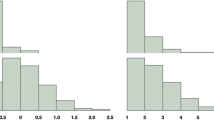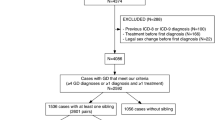Abstract
Ten (10) sets of siblings or parent–child pairs concordant for gender identity disorder (transsexualism) or gender identity disorder and transvestitism are reported. For concordant gender identity disorder, there is one set of male monozygotic twins; three sets of non-twin brothers; one brother-and-sister pair; one set of sisters; and one father and son. With gender identity disorder and transvestism, there is one transsexual father with a gender dysphoric; transvestic son; one transvestic father with a gender dysphoric, transvestic son; and one transvestic father with a transsexual daughter. The emerging technology of genetic markers makes collation of such families a potentially valuable resource for unraveling the origins of atypical gender identity.
Similar content being viewed by others
Change history
02 May 2022
Update: The Editor-in-Chief has removed Case Seven from this article in consultation with the Publisher for legal reasons.
REFERENCES
Anchersen, P. (1956). Problems of transvestism. Acta Psychiatr.Neurol.Scand.(Suppl) 106: 249–256.
Balen, A., Schacter, M., Montgomery, D., Reid, R., and Jacobs, H. (1993). Polycystic ovaries are a common finding in untreated female-to-male transsexuals. Clin.Endocrin. 38: 325–329.
Ball, J. (1981). Thirty years experience with transsexualism. Aust.NZ.J.Med. 15: 39–43.
Bosinski, H., Peter, M., Bonatz, G., Arndt, R., Heidenreich, M., Sippell, W., and Wille, R. (1997). A higher rate of hyperandrogenic disorders in female-to-male transsexuals. Psychoneuroendocrinology 22: 361–380.
Broadbent, L. (1996). Twin sisters who wanted to be men. Now 5 December, pp. 6–9.
Dorner, G., Poppe, I., Kolzsch, J., and Uebelhack, R. (1991). Gene and environment dependent neuroendocrine etiogenesis of homosexuality and transsexualism. Exp.Clin.Endocrin. 98: 141–150.
Eicher, W., Spoljar, M., Cleve, H., Murken, J., Richter, K., and Stengel-Rutkowski. (1979). H-Y antigen in trans-sexuality. Lancet 2: 1137–1138.
Freund, K. (1985). Cross-gender identity in a broader context. In Steiner, B. (ed), Gender Dysphoria: Development, Research, Management. Plenum, New York, pp. 259–324.
Futterweit, W., Weiss, R., and Fagerstrom, R. (1986). Endocrine evaluation of 40 female-to-male transsexuals. Arch.Sex.Behav. 15: 69–78.
Green, R. (2000). Birth order and ratio of brothers to sisters in transsexuals. Psychological Medicine.
Green, R., and Keverne, E. B. (2000). The disparate maternal aunt-uncle ratio in male transsexuals: An explanation invoking genomic imprinting. J.Theor.Biol. 202: 55–63.
Green, R., and Young, R. (2000). Fingerprint asymmetry in male and female transsexuals. Personality and Individual Differences.
Green, R., and Money, J. (eds.). (1969). Transsexualism and Sex Reassignment. Baltimore, The Johns Hopkins Press.
Green, R., and Stoller, R. (1971). Two pairs of monozygotic (identical) twins discordant for gender identity. Arch.Sex.Behav. 1: 321–328.
Gorzynski, G., and Katz, J. (1977). The polycystic ovary syndrome. Arch.Sex.Behav. 6: 215–222.
Hamer, D., Hu, N., Magnuson, V., Hu, N., and Pattatucci, A. (1993). A linkage between DNA markers on the X chromosome and male sexual orientation. Science 261: 321–327.
Hore, B., Phil, M., Nicolle, F., and Calnan, J. (1973). Male transsexualism: Two cases in a single family. Arch.Sex.Behav. 2: 317–321.
Hyde, C., and Kenna, J. (1977). A male MZ twin pair, concordant for transsexualism, discordant for schizophrenia. Acta Psych.Scand. 56: 265–275.
McKee, E., Roback, H., and Hollender, M. (1976). Transsexualism in two male triplets. Am.J.Psych. 133: 334–336.
Raboch, J., Kobilkova, J., Raboch, J., and Starka, L. (1985). Sexual life of women with Stein-Leventhal syndrome. Arch.Sex.Behav. 14: 263–270.
Sabalis, R., Frances, A., Appenzeller, S., and Mosely, W. (1974). The three sisters: Transsexual male siblings. Am.J.Psych. 131: 907–909.
Stoller, R., and Baker, H. (1973). Two male transsexuals in one family. Arch.Sex.Behav. 2: 323–328.
van Kesteran, P., Gooren, L., and Megens, J. (1996). An epidemiological and demographic study of transsexuals in the Netherlands. Arch.Sex.Behav. 25: 589–600.
Wachtel, S., Green, R., Simon, N., Reichardt, A., Cahill, L., Hall, J., Nokamura, D., Wachtel, G., Futterweit,W., Biber, S., and Ihlenfield, C. (1986). On the expression of H-Y antigen in transsexuals. Arch.Sex.Behav. 15: 49–66.
Zhou, J., Hofman, M., Gooren, L., and Swaab, D. (1995). A sex difference in the brain and its relation to transsexuality. Nature 378: 68–70.
Author information
Authors and Affiliations
Additional information
The Editor-in-Chief has removed Case Seven from this article in consultation with the Publisher for legal reasons. (2 May 2022)
Rights and permissions
About this article
Cite this article
Green, R. Family Cooccurrence of “Gender Dysphoria”: Ten Sibling or Parent–Child Pairs. Arch Sex Behav 29, 499–507 (2000). https://doi.org/10.1023/A:1001947920872
Published:
Issue Date:
DOI: https://doi.org/10.1023/A:1001947920872




